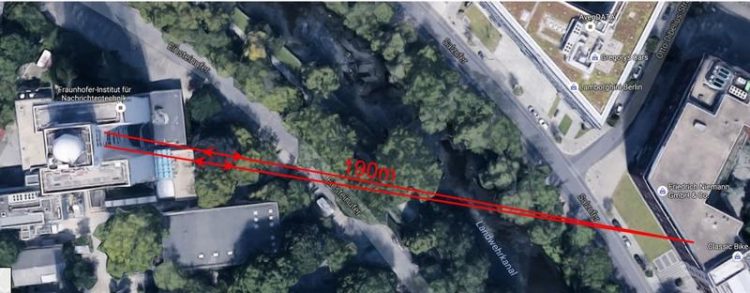2×1.7-Terabit/s eye-safe optical link demonstrated over 380 meters at Fraunhofer HHI

2x1.7-Terabit/s eye-safe optical link demonstrated over 380 meters at Fraunhofer HHI © Google Streetview
The measured bit-error rate of the channels fluctuated between 1E-8 and 0 without forward error correction.
The two bidirectional terminals were placed in the same building whereas a relay mirror was placed in the other building to increase the link distance.
Fine and coarse tracking systems stabilized the coupling into the single-mode fibers at both terminals.
This result was achieved with the support of Huawei Technologies. To increase the link distance to several kilometers, additional techniques, on which the Fraunhofer HHI is currently working, will be integrated to the terminals to mitigate optical turbulence effects.
Applications of interest are high-speed free-space Internet connects in converged city and access networks.
The fiber-based system that generates and demodulates the 1.7-Tbit/s signal was also successfully deployed over a free-space unidirectional 10-km link with the high-power free-space transmission system of the German Aerospace Center (Deutsches Zentrum für Luft- und Raumfahrt; DLR).
https://www.hhi.fraunhofer.de/en/press-media/press-releases.html
Media Contact
All latest news from the category: Information Technology
Here you can find a summary of innovations in the fields of information and data processing and up-to-date developments on IT equipment and hardware.
This area covers topics such as IT services, IT architectures, IT management and telecommunications.
Newest articles

Sea slugs inspire highly stretchable biomedical sensor
USC Viterbi School of Engineering researcher Hangbo Zhao presents findings on highly stretchable and customizable microneedles for application in fields including neuroscience, tissue engineering, and wearable bioelectronics. The revolution in…

Twisting and binding matter waves with photons in a cavity
Precisely measuring the energy states of individual atoms has been a historical challenge for physicists due to atomic recoil. When an atom interacts with a photon, the atom “recoils” in…

Nanotubes, nanoparticles, and antibodies detect tiny amounts of fentanyl
New sensor is six orders of magnitude more sensitive than the next best thing. A research team at Pitt led by Alexander Star, a chemistry professor in the Kenneth P. Dietrich…





















